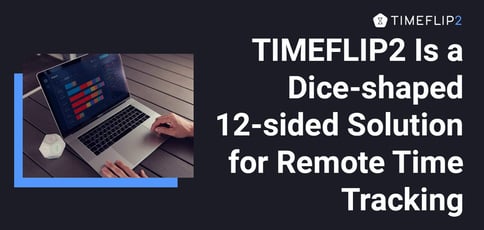
TL; DR: Believe it or not, we’re already in year four of post-pandemic life, so remote work has been the new norm for nearly half a decade. And yet, many of us haven’t quite nailed down how to keep our productivity boosted. I present a handy dodecagon called the TIMEFLIP2 by TimeFlip. We talked with CEO and founder Pavel Cheshev about how this small yet mighty device changes the game for freelancers, developers, remote workers, and just about everybody in between.
Before I started writing full-time, I was an independent contractor for years. I had several clients, from law firms to purebred dog breeders, so I quickly became acquainted with time-tracking apps to keep track of my work.
I used a time tracker for several reasons. For one, I loved the Pomodoro technique for quick bursts of work, knowing a break was a mere 25 minutes away. I also used it to track how long it took me to research certain topics or write a specific number of words, which helped me determine my hourly rates.
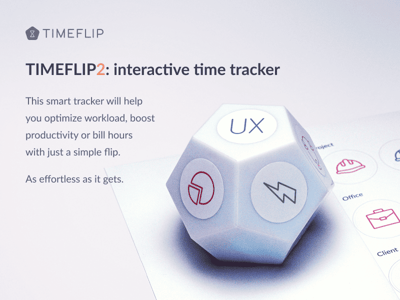
While time tracking apps may seem like a balancing act between trust and Big Brother, they serve a purpose beyond micromanagement: They’re a necessary tool that helps us take better responsibility for ourselves. More than 85% of 300 people surveyed agreed better time management would reduce stress at work, increase productivity, and improve focus. Plus, for us work-from-home folk, it helps set that boundary between work and home time.
TimeFlip has an elegant alternative to your typical time trackers, including the acclaimed Toggl or Harvest, because the TIMEFLIP2 is a physical tool.
“We have a lot of digital apps around us, and sometimes you want to work with something that feels more natural, something tangible,” said Pavel Cheshev, CEO and founder of TimeFlip.
The TIMEFLIP2, which is shaped like a 12-sided polyhedron resembling a dice, is equipped with LED lights for notifications — all without relying on an internet connection.
And if I’ve got your attention now, wait until you see it in action.
The TimeFlip Vision of Working Smarter
Pavel says the idea for TimeFlip came from David Rose’s approach to enchanted objects.
If you’re unfamiliar with this concept, here’s a quick rundown. Enchanted objects refer to how technology becomes a part of our everyday lives and the fabric of existence. Technology is more than just a device that automates or serves us — it’s an extension of our own selves.
I know I’m bordering the line of a “Black Mirror” episode here, but David Rose’s concept centers around the positive aspects of how technology can enhance our daily lives.
Take the Oombrella, which tells you the weather upon opening your umbrella; or the Mimobaby, which monitors your baby’s heart rate and body temperature. These are just a couple of examples, but you can see how technology integrates and interacts with us — almost like a reliable friend.
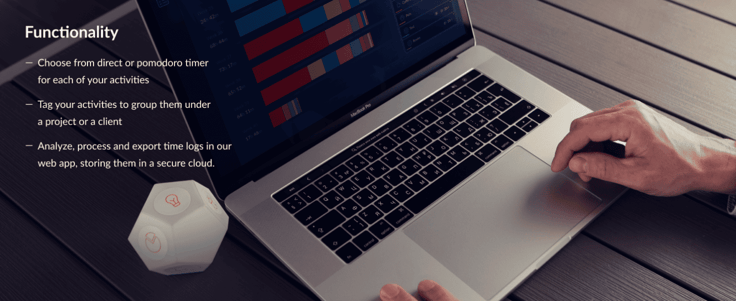
The TIMEFLIP2 is similar in concept. It’s a physical, polyhedron-shaped dice that, while connected to the internet and a piece of technology, doesn’t feel like it. Looking at it, I’m relieved it’s not just another screen for me to stare into.
“We understood that there was a barrier for many people to start tracking time because even if they have an app they want to use, they still have to learn the interface and remember to go back to the tab and start or stop the timer,” Pavel explained.
The key to TimeFlip is its ease of use. You flip your device instead of clicking a button on your web browser. The TimeFlip app automatically collects your time on a specific project and downloads the data to your web app or mobile app.
Integrating TIMEFLIP2 Into Daily Life
The tangible aspect of the TIMEFLIP2 is what sets it apart from traditional time-tracking software — making it more accessible and intuitive for those who need a break from their digital interfaces.
The polyhedron-shaped dice is about the size of an average hand, so it fits perfectly in most palms. When you receive your TIMEFLIP2, you can set up your tasks with premade label stickers or your own. You can add up to 12 tasks, including responding to emails, writing a blog post, taking lunch, working out, or doing specific projects.
When you unpack your TIMEFLIP2, here’s how it works:
- Follow TimeFlip’s unboxing and assembly instructions.
- Use the stickers provided to mark each facet of your TIMEFLIP2. You can choose from predefined icons or use blank stickers to draw your own labels.
- Open your TIMEFLIP2 mobile app and place the device on a surface.
- For each facet, define the name, icon, LED color, tag, hour rate (if it’s a billable task), and timer type (direct timing or Pomodoro technique).
- Use the tracking menu or tap directly on the TIMEFLIP2 to start or pause the timer for each facet.
What I like are the embedded LED lights for notifications. It’s a simple yet effective visual cue that lets you easily track your time without constantly referring back to a screen.
You can also group your tasks by tags, which you can customize on your TimeFlip app. And, if you’re curious, you can import the data to your device and see what kind of habits you’re creating.
“By having the basic data of how much time you spend across different tasks and being able to group tasks by projects or clients, you can better understand how your time is distributed with different projects or clients,” said Pavel.
The devs recently added calendar integration for Google, iCloud, and Outlook calendars.
“You can subscribe your calendar to your TIMEFLIP2 events so it’s easier to plan,” Pavel explained, with easy-to-follow documentation on their website.
Eventually, other integrations will come, too, including Slack, Jira, and IFTTT.
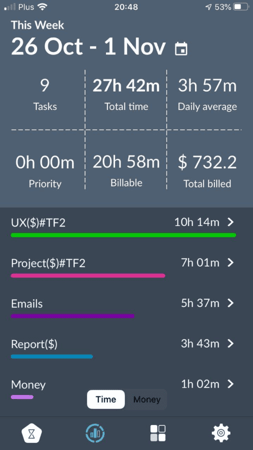
TimeFlip is for anybody, but it can be especially ideal for:
- Freelancers: Track projects and bill specific hours
- Developers: Manage projects, tasks, issues, and costs; track billable and non-billable time; set hourly rates; use tags to group tasks; and monitor time distribution
- Consultants: Track clients and meetings; manage billable and non-billable time; use tags to organize tasks under client assignments; and set hourly rates in their currency while tracking time
- Copywriters: Use the Pomodoro technique for focused work or work sprints, meet deadlines, and organize tasks under projects or clients using tags
- ADHD management: Stay organized with the Pomodoro timer and prioritize tasks using colored tags
You can also convert your data into an Excel spreadsheet or CSV format to see a daily, weekly, or monthly view of how you spent your time so you can identify patterns, areas of focus, or potential inefficiencies in your workflow.
Working remotely is a blessing, but when it’s not used correctly, it can be a curse. Keeping track of how you spend your time is one of the best ways to keep your work consistent and maybe even improve it in areas you didn’t know you needed.
What’s Next? UX at the Forefront
TIMEFLIP2 is the latest version of the TimeFlip product and comes with several improvements over the previous version. What’s really neat is you can invent your own use case by leveraging its API (Application Programming Interface). For example, you could modify it to function as a health and wellness tracker.
“We are a small team, and I really enjoy engaging with everyone because it’s super cool to see our community grow,” said Pavel. “We try to offer our users as much advice as we can since we use the device ourselves. So we can advise people based on what their use case is, how to best use the device, and if there are any specific questions.”
As for what’s next, Pavel assures the TimeFlip community that the dev team is listening. TimeFlip is prioritizing user experience (UX) with upcoming integrations for workspace messenger Slack, project tracking software Jira, and automation tool IFTTT.
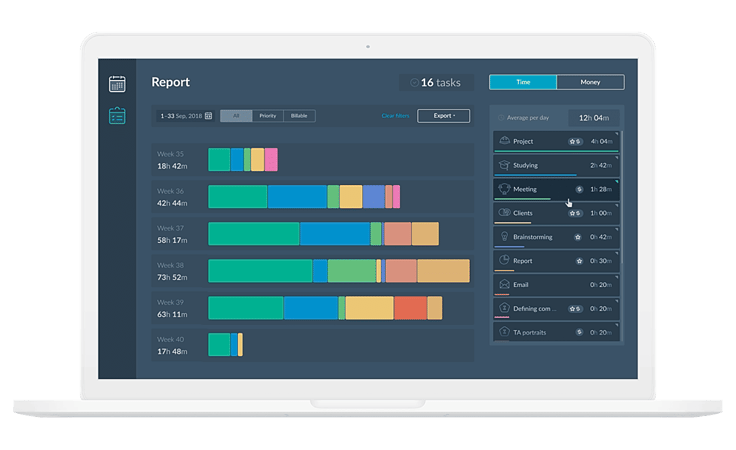
“The idea behind this is that we have different tasks of different natures: We have creative and routine tasks, and we shall approach them differently. The peaks of our energy should go for the more creative tasks, so that’s not the task we should start with because then we’re burnt out for the rest of the day,” said Pavel, referring to the work structure theory that says for some people, it’s better to start with the most challenging or boring task first.
“Our goal is to help you make smart use of your time, so it’s not that you work less, but you work smarter,” Pavel said. “So you can have more time for yourself and have a better, more balanced life with less stress just by organizing your time in the proper way, and that’s also a playful way.”
Get your own TIMEFLIP2 starting at $59. The software won’t cost you a dime for as long as you have it, and you get a 30-day money-back guarantee and a 1-year warranty.



